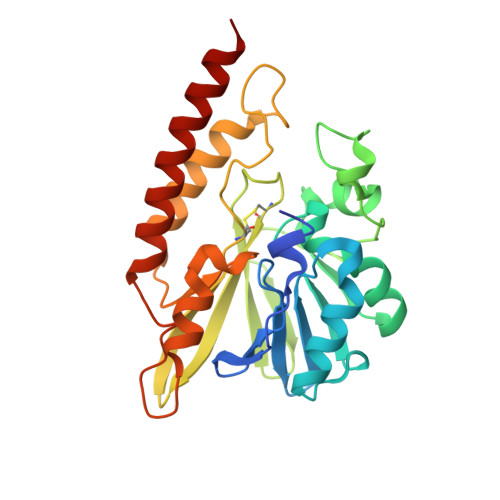Postgenomic scan of metallo-beta-lactamase homologues in rhizobacteria: identification and characterization of BJP-1, a subclass B3 ortholog from Bradyrhizobium japonicum.
Stoczko, M., Frere, J.M., Rossolini, G.M., Docquier, J.D.(2006) Antimicrob Agents Chemother 50: 1973-1981
- PubMed: 16723554
- DOI: https://doi.org/10.1128/AAC.01551-05
- Primary Citation of Related Structures:
2GMN - PubMed Abstract:
The diffusion of metallo-beta-lactamases (MBLs) among clinically important human pathogens represents a therapeutic issue of increasing importance. However, the origin of these resistance determinants is largely unknown, although an important number of proteins belonging to the MBL superfamily have been identified in microbial genomes. In this work, we analyzed the distribution and function of genes encoding MBL-like proteins in the class Rhizobiales. Among 12 released complete genomes of members of the class Rhizobiales, a total of 57 open reading frames (ORFs) were found to have the MBL conserved motif and identity scores with MBLs ranging from 8 to 40%. On the basis of the best identity scores with known MBLs, four ORFs were cloned into Escherichia coli for heterologous expression. Among their products, one (blr6230) encoded by the Bradyrhizobium japonicum USDA110 genome, named BJP-1, hydrolyzed beta-lactams when expressed in E. coli. BJP-1 enzyme is most closely related to the CAU-1 enzyme from Caulobacter vibrioides (40% amino acid sequence identity), a member of subclass B3 MBLs. A kinetic analysis revealed that BJP-1 efficiently hydrolyzed most beta-lactam substrates, except aztreonam, ticarcillin, and temocillin, with the highest catalytic efficiency measured with meropenem. Compared to other MBLs, BJP-1 was less sensitive to inactivation by chelating agents.
Organizational Affiliation:
Dipartimento di Biologia Molecolare, Laboratorio di Fisiologia e Biotecnologia dei Microrganismi, Università di Siena, Italy.















